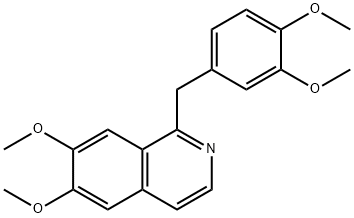-
種類
パパベリンは、通常塩酸塩 (cas登録番号: 61-25-6) として販売されています。パパベリン塩酸塩は、化学式C20H22ClNO4で表される分子量375.85の白色結晶または結晶性粉末です。
融点は、220〜225℃で、アルコールやクロロホルムに溶け、水へは25mg/mlの溶解性を持ちます。
-
性質
化学式はC20H21NO4で表され、分子量は339.39です。CAS番号は58-74-2で登録されています。パパベリンは融点147°C、常温で白色結晶性、密度1.337g/ml (20℃) の固体です。
光や湿気に不安定な性質を持ちます。アルコールやエーテル、アセトン、ベンゼン、ピリジンなどに溶けます。クロロホルムや石油エーテルへの溶解度は低く、水へは17 °Cで35mg/Lとほとんど溶けません。
酸性・アルカリ性の程度を表すpHは2.0〜2.8、酸解離定数 (pKa) は8.07 (25 °C) です。酸解離定数とは、酸の強さを定量的に表すための指標の1つです。pKa が小さいほど強い酸であることを示します。
-
解説
6,7-dimethoxy-1-(3,4-dimethoxybezyl)isoquinolien.C20H21NO4(339.39).パパベリンは,アヘン中に0.8~1.0% 存在するアヘンアルカロイドの一つ.典型的なベンジルイソキノリンアルカロイドで,現在は合成により得られる.柱状晶.融点147 ℃.モルヒネより麻酔作用は弱く,平滑筋,とくに血管筋を弛緩させる.塩酸塩は,融点220~225 ℃.鎮けい薬,血管収縮剤として用いる.LD50 650 mg/kg(マウス,経口).[CAS 58-74-2][CAS 61-25-6:塩酸塩] 森北出版「化学辞典(第2版)
-
副作用
便秘やめまい、ほてり、口の渇き、動悸などが報告されています。重篤な副作用は特になく、安全性の高い薬として知られています。
眼圧上昇を引き起こす恐れがあるため、緑内障患者への使用には注意してください。
-
効能
鎮痙薬, 平滑筋弛緩薬, 血管拡張薬, ホスホジエステラーゼ阻害薬
-
化学的特性
White crystalline powder; obtained asorthorhombic prisms from an alcohol–ethermixture; melts at 147°C (296.6°F); sublimesunder vacuum; insoluble in water; soluble inacetone, glacial acetic acid, and benzene.
-
使用
folate metabolic inhibitor, coccidiostat
-
定義
ChEBI: A benzylisoquinoline alkaloid that is isoquinoline substituted by methoxy groups at positions 6 and 7 and a 3,4-dimethoxybenzyl group at position 1. It has been isolated from Papaver somniferum.
-
適応症
Papaverine (Pavabid) is a nonspecific phosphodiesterase
inhibitor that increases cAMP and cGMP levels
in penile erectile tissue. Papaverine is particularly
known as a smooth muscle relaxant and vasodilator. Its
principal pharmacological action is as a nonspecific vasodilator
of smooth muscles of the arterioles and capillaries.
Various vascular beds and smooth muscle respond
differently to papaverine administration both in
intensity and duration. Papaverine decreases the resistance
to arterial inflow and increases the resistance to
venous outflow.
-
健康ハザード
Papaverine is an inhibitor of cyclic nucleotidephosphodiesterase, producing vasodilatoryeffect. The acute toxic effects relative tophenanthrene-type opium alkaloids (e.g.,morphine, heroin) are low and the symptomsare not the same. Papaverine is neither a narcoticnor an addictive substance. Excessivedoses may produce drowsiness, headache,facial flushing, constipation, nausea, vomiting,and liver toxicity.
The LD50 data reported in the literatureshow variation. An oral LD50 value in rats ison the order of 400 mg/kg.
-
化学合成
パパベリンの生成法は、アヘンから単離する方法と化学合成による方法の2種類です。現在は、化学合成により得る方法が主流です。
フェネチルアミンとアシルクロライドのショッテン・バウマン反応 (英: Schotten-Baumann Reaction) によりアミドを合成した後、五酸化リンを用いたビシュラー・ナピエラルスキー反応 (英: Bischler-Napieralski Reaction) と呼ばれる環化反応により3,4-ジヒドロイソキノリンを得ます。続いて温和な条件下、脱水素反応によりパパベリンが合成できます。
-
使用用途
パパベリンは、医薬品に使用され、アヘン中に0.8〜1%存在します。同じくアヘンから抽出されるモルヒネと比べ、中枢への作用や麻酔効果は弱いです。中枢作用の代わりに、パパベリン塩酸塩は、内臓平滑筋や血管平滑筋を弛緩させる作用を持ちます。
内臓を動かしている平滑筋の異常性緊張や痙れんを抑制させるため、消化管の緊張による腹痛を緩和することが可能です。具体的には、胃炎や胆管・胆のう系の疾患に伴う内臓平滑筋の痙攣に用いられます。
また、血管平滑筋の弛緩により、血行を促進することも可能です。具体的には、急性動脈塞栓や急性肺塞栓、冠循環障害、末梢循環障害による血管の拡張および、上記症状の改善に使用されます。
-
作用機序
When administered by intracavernosal injection, papaverine, a weak and nonspecific PDE inhibitor, is thought to cause relaxation of the cavernous smooth muscles and vasodilation of the penile arteries by inhibition of PDE. These effects result in increased arterial blood flow into the corpus cavernosa and in swelling and elongation of the penis. Venous outflow also is reduced, possibly as a result of increased venous resistance.
-
臨床応用
Papaverine is highly effective in men with psychogenic
and neurogenic ED but less effective in men
with vasculogenic ED. Papaverine–phentolamine combinations
have been used in self-injection procedures.
Papaverine doses may range from 15 to 60 mg. Papaverine
treatment in patients with severe arterial or venous
incompetence is usually unsuccessful, but autoinjections
using low doses sufficient to achieve an erection
are safe and efficient.
-
副作用
Major side effects associated with papaverine therapy
include priapism, corporeal fibrosis, and occasional
increases in serum aminotransferases. Intracorporeal
scarring may be related to the low pH of the vehicle that
is necessary to solubilize papaverine.Attempts to buffer
papaverine to render it more suitable for intracavernosal
injection have not been entirely satisfactory, and
such delivery may still lead to intracorporeal scarring.
-
安全性プロファイル
Poison by ingestion, intramuscular, subcutaneous, intradermal, intraperitoneal, and intravenous routes. Human systemic effects: coma, somnolence. Its central nervous system action is about midway between those of morphme and codeine, and large doses do not produce the amount of excitement caused by codeine or the soporific action of morphine. Mutation data reported. A cerebral vasodilator and smooth muscle relaxant. Combustible when exposed to heat or flame. When heated to decomposition it emits toxic fumes of NOx. See also MORPHINE.
-
概要
パパベリン (英: Papaverine) とは、アヘンアルカロイドの1種です。
IUPAC名は1- [ (3,4-ジメトキシフェニル) メチル] -6,7-ジメトキシ-イソキノリン (英: 1- [ (3,4-dimethoxyphenyl) methyl] -6,7-dimethoxyisoquinoline) です。別名として、6,7-ジメトキシ-1- (3,4-ジメトキシベンジル) イソキノリン (英: 6,7-Dimethoxy-1- (3,4-dimethoxybezyl) isoquinolien) やRobaxapapとも呼ばれます。

